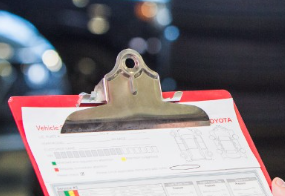After an arduous, challenging Canadian winter, it’s time to liven up your car. It may need a detailed cleaning, full servicing, or just a bit of fine-tuning to get it ready for the warmer months ahead.
Having a Toyota maintenance plan is necessary, so you know the strengths and weaknesses of your vehicle in its current state and make adjustments accordingly. Here’s a vehicle spring maintenance checklist to follow when you look after your Toyota as the season evolves.
1. Take It Out for Servicing
The best thing you can do when addressing Toyota maintenance is to ensure your vehicle gets proper coverage from back to front. That way your Toyota is covered for longer in the event of any damage or defects.
There are two main prepaid maintenance plans: Toyota Extra Care Protection in Gold or Platinum, which can help you cut rising maintenance costs. These plans give extra coverage and protection that your Toyota’s New Vehicle Warranty does not include, or it extends the coverage for longer. Coverage includes various mechanical groups, such as your engine, transmission, cooling system, fuel system, brakes, electrical systems, suspension, and more.
With the Gold and Platinum levels, you can pick the plan that makes the most sense for you and how you drive your Toyota. You can pick different lengths of coverage up to 7 years or 200,000 km (whichever comes first). You can also purchase the Extra Care Protection Road Hazard Warranty or the Oil & Filter Service/Inspection Program.
The ECP Road Hazard Warranty covers damage caused to your original factory tires by road hazards for up to 36 months, 50,000 km, or until the Treadware Indicator on the tires become visible (whichever comes first). It covers the cost of the parts, labour, installation, balancing, as well as applicable taxes that you have to pay a dealer to fix or replace the damaged tires.
The ECP Oil & Filter Service/Inspection Program comes at a Gold or Platinum level. The Gold level includes four oil and filter services as well as one tire rotation, as well as a two-year maintenance service program. The Platinum level includes eight oil and filter services and one tire rotation, as well as a three-year maintenance service program.
2. Look After All Your Car’s Fluids
Spring is an ideal time to check your car’s fluids, flushing them and topping them off where necessary. Your Toyota owner’s manual provides you with the recommended service schedule, so you can plan this ahead of time. You should ideally be checking those fluids each month to ensure there’s nothing unusual going on. If you notice that certain fluids in your Toyota seem low or that there are any small leaks, it’s time to get your car checked. Have your mechanic check the oil and examine the transmission fluid and brake fluid to change what’s needed.
3. Fix the Air Conditioning
The air quality will improve as the temperatures and overall surroundings do, but with increasing heat, you’re going to need to keep yourself cool whenever you’re driving. That means it’s time to check the AC. This system creates a more comfortable environment in your car when driving as the sun pelts down, but it can also become a safety threat if you don’t address it soon enough.
While spring weather isn’t as unpredictable as that of winter, the temperature will swing from time to time due to rain, fog, and other elements. Whenever you defog your windshield, the air conditioner is engaged. If your air conditioner is not performing at its best, this can fog your windows and decrease your visibility while driving. Inspect it right away for any leaks or debris build-up so that you’re not putting yourself at risk. Ensure the AC coolant is full as well.
4. Give Your Toyota a Deep Clean
Not only does the often-used term ‘spring cleaning’ apply to your home, but it’s also appropriate for your car. As a part of your vehicle spring maintenance, take some time to deep clean your vehicle, inside and out. Clean your car mats, upholstery, centre console, and vacuum your seats. Ensuring that your interior both looks and smells clean.
And, of course, your exterior will need proper cleaning after all the salt and precipitation accumulation during the harsh winter months. Taking your car to a quality car wash will make things easier for you. You can also add a fresh coat of wax or two to protect its paint and repair any paint chips collected during your winter driving.
5. Check Your Tires and Brakes
If you still have winter tires on your Toyota and temperatures are reasonably warm, it’s time to swap them for their summer alternative. Before changing, check your winter tires for any scratches, gashes, or misalignment, so you know whether it’s time to get new winter tires for next winter in advance.
If you already had your summer tires stashed away in your garage, check their air quality while also looking at their wear and tear. Additionally, you should check the tread depth and for any uneven wear. You want to make sure all your tires have the same traction and wear, so your Toyota feels balanced and safe.
As for your brakes, these are best left to a Toyota professional who can evaluate the wear on the brake pads as well as the discs for rough spots. Any noticeable wear on the discs or any suspicion that the pads are too thin should lead you to ask the service professional to change your brakes right away.
Toyota Vehicle Care should be comprehensive, sparing you from dangerous situations and saving you money down the line. Visit Georgetown Toyota today to get the best Toyota model to suit your needs this spring!







